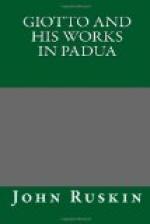* * * * *
XVII.
THE WISE MEN’S OFFERING.
This is a subject which has been so great a favourite with the painters of later periods, and on which so much rich incidental invention has been lavished, that Giotto’s rendering of it cannot but be felt to be barren. It is, in fact, perhaps the least powerful of all the series; and its effect is further marred by what Lord Lindsay has partly noted, the appearance—perhaps accidental, but if so, exceedingly unskilful—of matronly corpulence in the figure of the Madonna. The unfortunate failure in the representation of the legs and chests of the camels, and the awkwardness of the attempt to render the action of kneeling in the foremost king, put the whole composition into the class—not in itself an uninteresting one—of the slips or shortcomings of great masters. One incident in it only is worth observing. In other compositions of this time, and in many later ones, the kings are generally presenting their offerings themselves, and the Child takes them in His hand, or smiles at them. The painters who thought this an undignified conception left the presents in the hands of the attendants of the Magi. But Giotto considers how presents would be received by an actual king; and as what has been offered to a monarch is delivered to the care of his attendants, Giotto puts a waiting angel to receive the gifts, as not worthy to be placed in the hands of the Infant.
* * * * *
XVIII.
THE PRESENTATION IN THE TEMPLE.
This design is one of those which are peculiarly characteristic of Giotto as the head of the Naturalisti.[21] No painter before his time would have dared to represent the Child Jesus as desiring to quit the arms of Simeon, or the Virgin as in some sort interfering with the prophet’s earnest contemplation of the Child by stretching her arms to receive Him. The idea is evidently a false one, quite unworthy of the higher painters of the religious school; and it is a matter of peculiar interest to see what must have been the strength of Giotto’s love of plain facts, which could force him to stoop so low in the conception of this most touching scene. The Child does not, it will be observed, merely stretch its arm to the Madonna, but is even struggling to escape, violently raising the left foot. But there is another incident in the composition, witnessing as notably to Giotto’s powerful grasp of all the facts of his subject as this does to his somewhat hard and plain manner of grasping them;—I mean the angel approaching Simeon, as if with a message. The peculiar interest of the Presentation is for the most part inadequately represented in painting, because it is impossible to imply the fact of Simeon’s having waited so long in the hope of beholding his Lord, or to inform the spectator of the feeling in which he utters the




